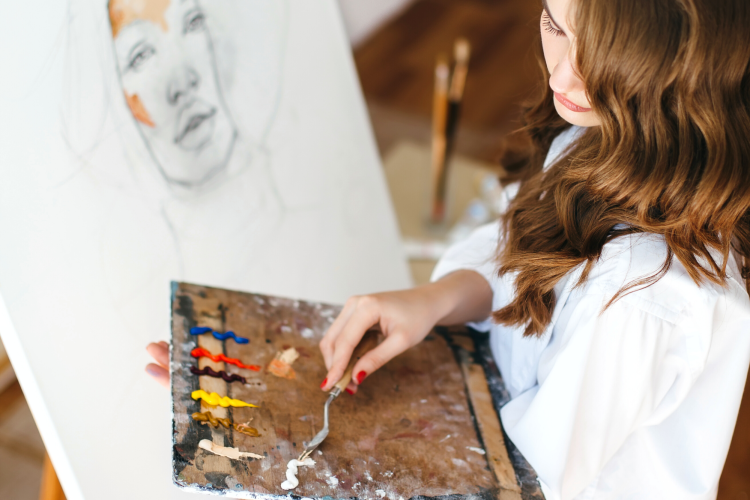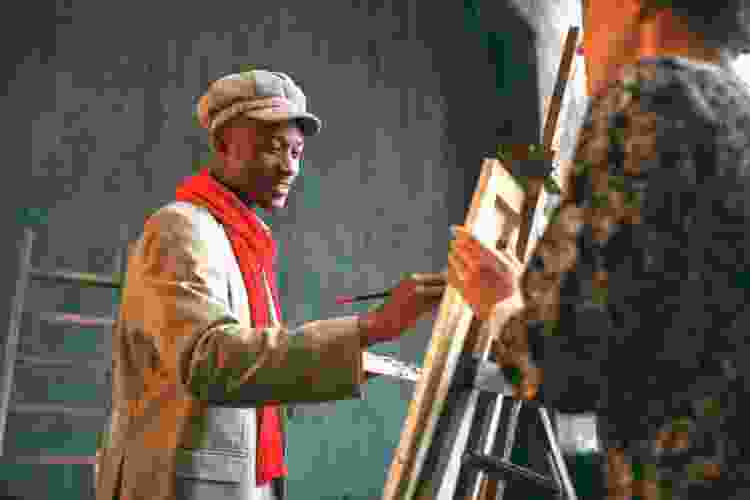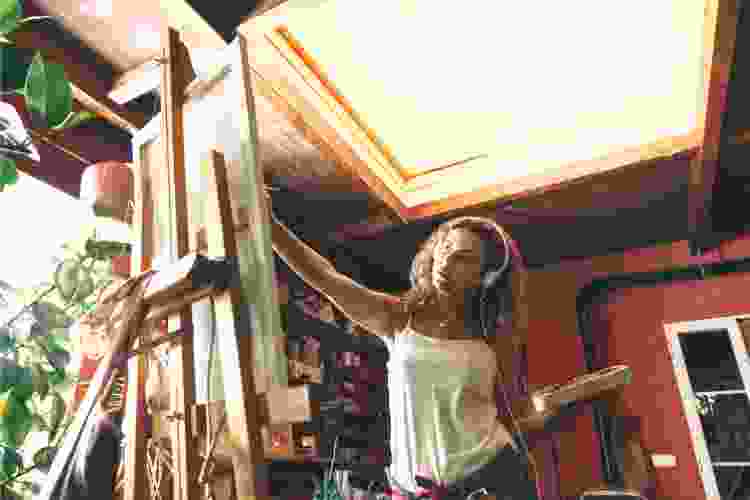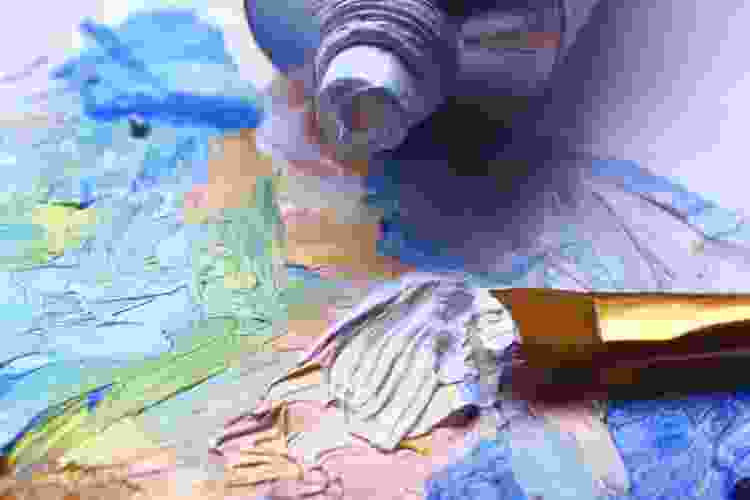A Beginner’s Guide to Oil Painting

What does oil painting for beginners look like? It’s a fun, meditative activity that exercises your imagination. It’s also a fulfilling way to spend free time, an excellent medium to express your creativity and a great confidence builder.
You can’t go wrong — anyone can learn oil painting basics. Oil painting on canvas is simply a matter of learning shading and brushstroke techniques, color mixing, layering and other basic skills.
The oil painting tutorial below explains what oil painting materials you’ll need, offers oil painting tips and recommends how to set up your oil painting space. Read on to learn everything you need to know about oil painting for beginners!
Jump to Section
- Learn Oil Painting Basics
- Easy Oil Painting for Beginners
- Set Up Your Oil Painting Space
- Oil Painting Materials
- Oil Painting on Canvas
- Oil Painting Tips
Learn Oil Painting Basics
The most effective way to begin your oil painting journey is with fun, interactive oil painting for beginners classes. In painting classes, talented artists explain oil painting basics: brushstrokes, blending, layering and scumbling. You’ll learn how to create beautiful works using basic oil painting materials.
You can even make a splash by adding your favorite beverage to your art session with fun paint and sip in Chicago, paint and sip in Los Angeles, paint and sip in NYC, or paint and sip near you. For those who prefer to learn from the comfort of home, online painting classes are always a great option!
Oil painting takes practice. With the help of a qualified teacher, novices can paint pieces that will impress friends, family and most importantly: yourself. Practicing art is deeply satisfying and has many positive benefits.
In fact, according to the Indian Journal of Positive Psychology, "artistic self-expression helps people to resolve conflicts and problems, develop interpersonal skills, manage behavior, reduce stress, increase self-esteem and self-awareness, and achieve insight." Wow! When it comes to oil painting for beginners, there are really no downsides.

Easy Oil Painting for Beginners
Oil Paint
The first step when learning how to start oil painting is to understand your paint. Oil paint consists of a pigment, oil as a binder and a solvent. This painting medium allows for a versatile array of colors, shades and thickness.
The result is stunning artwork. History’s most revered painters — Van Gogh, Picasso, Leonardo da Vinci, Rembrandt paintings — all preferred oil paint. Even the best Norman Rockwell paintings used oil on canvas.
The Basics of Oil Painting for Beginners
Experienced oil painters recommend painting the furthest away objects — those that require darker but thinner colors, such as skies or shadows — first. Then you should progressively layer on the more intricate details with lighter but thicker paint.
For instance, if painting a woman sitting in a park, the painter should first paint the sky and other background material using long brushstrokes. As the painting progresses, layer on thicker, brighter colors using smaller brushstrokes.
The intricate contours of the woman’s face should be painted last with tiny brushstrokes. This method is referred to as “light over dark” — and it’s a great rule of thumb for oil painting for beginners.
The painting class instructor will further elaborate on shading techniques, color combinations, brushstroke tricks and other oil painting basics. Oil painting for beginners doesn’t need to be hard. With the right teacher, you’ll be whipping up beautiful pieces in no time.

Set Up Your Oil Painting Space
There’s no need for a fancy art studio to start oil painting for beginners. A comfortable, quiet room big enough to fit your supplies will suffice. Maybe that’s your living room, your study or your kitchen. The most important thing is that you’re comfortable. Your work area should be a serene space where your creativity will flourish.
Ideally, it’s also a place you don’t mind getting a bit messy. Prevent paint stains by covering the floor with newspaper. The space also needs to be big enough to house your oil painting materials: paint, brushes, a palette, an easel, a canvas, wash jars, a stool, oil, rags and whatever else you need.
Some experts also recommend positioning a mirror opposite your painting. You can then periodically glance at your painting through the mirror to get a different perspective, which is especially helpful in oil painting for beginners.

Oil Painting Materials
What do you need to get started with oil painting? Before you begin working, you need the proper oil painting materials. The following items are essential for oil painting for beginners.
- Paint. Oil paints vary widely in price and quality. Affordable, high-quality oil paints are available at many online retailers and brick and mortar art shops. The specific colors are up to you, but these are bare essentials: white, black, red, blue and yellow.
- Brushes. High-end, expensive brushes are made from hog hair or horse hair. They maintain their shape longer than synthetic brushes. For oil painting for beginners, synthetic brushes suffice, but if you want to splurge on the fancy stuff, go right ahead. Buy a pair of small brushes, a pair of medium brushes and a pair of large brushes.
- Palette. Basically anything can be used as a palette, including a plate, a piece of wood or tinfoil. But if you want to make things easier for yourself, invest in an inexpensive plastic palette, which is easy to clean and to mix paint in.
- Canvas. Most experts recommend using a canvas primed with gesso. A unique feature of oil paint is its versatility: both glass and wood can also be used as a canvas.
- Easel. An easel is essential for easy oil painting. It props up your canvas so that you won’t need to hunch over a table.
- Solvent. These days, many oil painters forgo solvent altogether. If you do buy a cleaning fluid, go with something non-toxic, such as Gamsol OMS.
- Linseed oil. This oil is used to thin the paint to achieve desired consistency.

Oil Painting on Canvas
Oil painting for beginners usually means oil painting on canvas. The highest-quality and most expensive canvases are made from linen. The rest are made from cotton. The size and texture of the canvas depends on the specific needs of the artist. Finely woven canvases are ideal for small brush strokes and detailed work, while rougher canvases are ideal for large brushstrokes and broader work.
For beginners, a medium-size (12 by 16 inches), pre-primed cotton canvas is perfect. Don’t worry about the texture; oil painting for beginners is simply about getting your bearings and sharpening your skills. You can focus on the intricacies of the canvas further down the road.
Oil Painting Tips
The best advice when it comes to oil painting for beginners is to utilize few simple tricks. The following oil painting tips will propel you in the right direction. Simple oil painting is at your fingertips (literally)!
- Hold the paintbrush by its tail end.
- Pre-tone the canvas with an earthy color.
- Sketch your image before you start painting.
- Start by painting background areas and shadows first using large brushstrokes.
- Progressively layer increasingly thick, prominent colors — using smaller brushstrokes — as you move to the foreground and more detailed areas.
- Let each layer dry before moving on to the next layer.
- White and black are your best friends. Master shading with these two colors before moving onto more complex combinations.
- To achieve semi-transparent paint, also known as glazing, add linseed oil to it.
- To achieve an airy effect, paint a light opaque color, such as white, over a darker color. This is called scumbling.
- To glaze your paint (make it more transparent), add linseed oil to it.
- Keep your paint fresh by wrapping your paint-filled palette in aluminum foil and storing it in the freezer.

With our oil painting tutorial under your belt, you’re now equipped with all the knowledge you need to start oil painting. Oil painting for beginners takes practice, but your skills will quickly improve, especially when you continue learning with an instructor. Try painting classes in Orange County, painting classes in San Jose or a city near you!
Easy oil painting is a brushstroke away. Don’t wait — use the above oil painting for beginners tips and classes, and start painting today!
For even more fun painting ideas, check out other experiences happening on Classpop!

